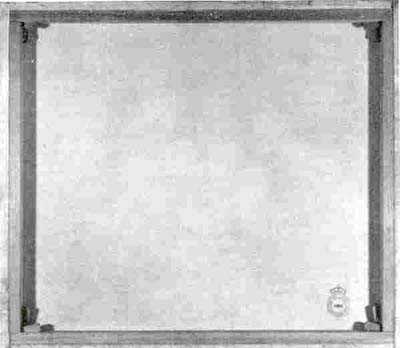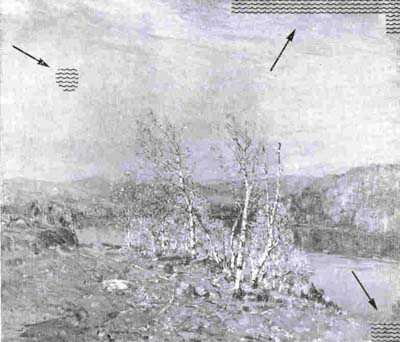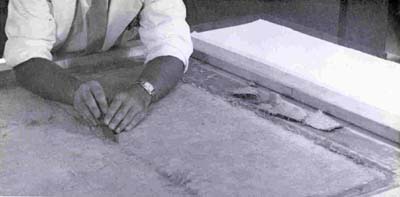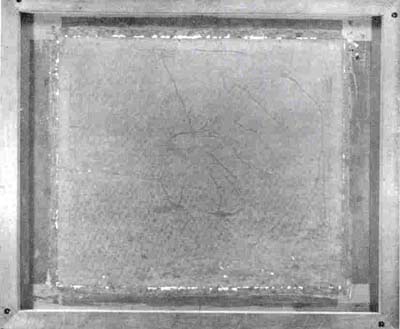
Bulletin 5 (III:1), 1965
Home
Français
Introduction
History
Annual Index
Author &
Subject
Credits
Contact
![]()





![]()
Conservation
Treatment of a Painting
by the Transfer Method
by Mervyn Ruggles,
Conservator,
National Conservation and Research Laboratory
Résumé en français
Page 1 | 2
| 3
In June 1963 during the course of periodic inspection of the
National Gallery collection, the Franklin Brownell (1) painting, Autumn
on the Gatineau, after closer examination, was round to have
developed paint cleavage (Fig. I) in several areas and partial
separation from the support fabric. Normal consolidation procedure
for this type of symptom is to infuse adhesive through the
interstices of the canvas to the ground preparation and to apply
gentle pressure from the front. A new lining canvas (2) is usually
added to reinforce the original support by means of a
non-hygroscopic thermosetting adhesive. (3)
The Brownell landscape had already been lined in 1944 (Fig. 2) and
now additional treatment was required. Under the binocular
microscope examination of the paint cleavage located at upper edge
to the right and near lower right corner (Fig. 3) revealed that
separation was occurring between the commercially prepared ground
layer and the fibres of the original support. In the light of this
information, the decision was made to remove the auxiliary canvas so
that further infusion of adhesive could be attempted.
The original support, identified as jute fibre woven with 12 warp
and 12 weft threads per inch, was covered by the commercially
applied ground 1.2 mm in thickness. This type of artists' canvas was
in fairly common use in eastern Canada during the 1916 to 1920
period. Cotton canvas had been employed as the lining material.
Actual paint thickness ranges between 1 mm to 2.5 mm.
The first step in the conservation procedure (4) consisted in
temporarily protecting the whole paint surface by applying wet
strength tissue facing paper with diluted parchment size and
stretching the painting on a temporary framework by means of paper
strips. (5) By doubling back the auxiliary cotton canvas and pulling
carefully the liner could be peeled off easily. At this stage, the
layer of water-soluble animal glue remaining over the jute was round
to be filling the interstices of the jute but had not penetrated
sufficiently to the ground layer. This disclosure confirmed what had
already been suspected during the examination. Furthermore, the
impossibility of bringing about efficient infusion of the proposed
thermosetting adhesive through the jute was now apparent.
Tests in marginal locations indicated that the jute could be shaved
off carefully without undue danger to the underlying strata. Steps
were now taken to carry out the unusual procedure of complete
removal of the original canvas and to 'transfer' the paint and
ground layers to an entirely new support. This operation is to be
avoided if at all possible and is undertaken only when other
treatment is not feasible.
Figure 4 illustrates the method employed to remove the jute threads
after the front of the picture has been firmly sealed to a 1/8
inch-thick cardboard (6) under vacuum on the hot table. (7,8) The
cardboard in position (Fig. 5) provides a rigid support while the
jute fibres are shaved off with a knife blade. The back of the
landscape with the jute completely removed, revealing the ground
layer, can be seen in Fig. 6.
The new flax canvas (9) having been prepared by impregnation with
warm wax adhesive, and the back of the painting coated in like
manner using the same adhesive, bonding of the two was carried out
on the vacuum hot table. After this stage, the cardboard front was
no longer necessary having served its purpose and was peeled away as
demonstrated in Figs. 7a and 7b. Removal of the tissue paper facing
was accomplished by using naptha-water emulsion (Fig. 8).
The specially designed hot table (Fig. 9) at the National
Gallery consists of a 3/8 inch-thick aluminum plate 5 x 8 feet,
heated by electrical elements (10) sealed to the underside. The peak
temperature during operation was 76° Centigrade. A temperature
controller prevents overheating. Uniform pressure over the whole
surface of the painting is achieved by covering the canvases with a
thin rubber latex sheet and withdrawing air by means of a vacuum
pump connected to the table, thus allowing the atmosphere to press
the two fabrics together until cooled to room temperature by means
of a built-in fan. The curve in Fig. 10 illustrates the heating
cycle as charted automatically while the vacuum hot table is
functioning, in this instance for 135 minutes duration.
The appearance of Autumn on the Gatineau after the old
yellowed damar varnish coating had been dissolved away with diluted
diacetone is shown in Fig. 11, where white spots are gesso luting
material used to compensate for old paint losses. These were
inpainted with pigment in normal butyl methacrylate medium. Finally,
two applications of normal butyl methacrylate resin dissolved in
xylene were sprayed over the surface after a two week drying period.
Next Page | More
images
1 |
2 | 3
Annual Index | Author & Subject | Credits | Contact
This digital collection
was produced under contract to Canada's Digital Collections program,
Industry Canada.
"Digital
Collections Program, Copyright
© National Gallery of
Canada 2001"